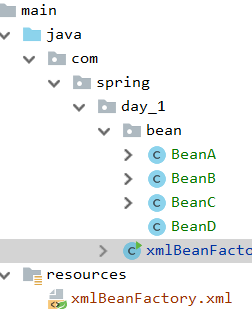@Resource 的注入原理分析
阿新 • • 發佈:2018-12-20
前言:上一篇 @Autowired 的注入原理分析 講了@Autowired的注入是由AutowiredAnnotationBeanPostProcessor完成的,而@Resource 的注入過程是由 CommonAnnotationBeanPostProcessor 完成的。
是Spring中用於處理JavaEE5中常用註解(主要是EJB相關的註解)和Java6中關於JAX-WS相關的註解,可以處理PostConstruct、@PreDestroy等Bean生命週期相關事件的註解,該後置處理最核心的是處理@Resource註解,同時還可以處理JAX-WS相關的註解,按照
準備以下程式碼:
@Service
public class BeanC {
@Resource
private BeanD beanD;
}
@Service
public class BeanD {
}
xml檔案:
<beans xmlns="http://www.springframework.org/schema/beans"
xmlns:xsi="http://www.w3.org/2001/XMLSchema-instance"
xmlns:content="http://www.springframework.org/schema/context"
xsi:schemaLocation="http://www.springframework.org/schema/beans
http://www.springframework.org/schema/beans/spring-beans.xsd
http://www.springframework.org/schema/context
http://www.springframework.org/schema/context/spring-context.xsd">
<content:component-scan base-package="com.spring.day_1.bean"/>
</beans>xml工廠(沒有@Resource的處理功能的)
public class xmlBeanFactory {
public static void main(String[] args) {
XmlBeanFactory beanFactory = new XmlBeanFactory(new ClassPathResource("xmlBeanFactory.xml"));
BeanC beanc = (BeanC) beanFactory.getBean("beanC");
System.out.println("stop");
}目錄結構:

debug後檢視beanC;

修改程式碼:
public class xmlBeanFactory {
public static void main(String[] args) {
XmlBeanFactory beanFactory = new XmlBeanFactory(new ClassPathResource("xmlBeanFactory.xml"));
CommonAnnotationBeanPostProcessor commonAnnotationBeanPostProcessor = new CommonAnnotationBeanPostProcessor();
commonAnnotationBeanPostProcessor.setResourceFactory(beanFactory);
commonAnnotationBeanPostProcessor.setBeanFactory(beanFactory);
beanFactory.addBeanPostProcessor(commonAnnotationBeanPostProcessor);
BeanA beanA = (BeanA) beanFactory.getBean("beanA");
BeanB beanB = (BeanB) beanFactory.getBean("beanB");
BeanC beanc = (BeanC) beanFactory.getBean("beanC");
System.out.println("stop");
}
}

現在就注入成功了。
過程分析:
關於postProcessPropertyValues 這個方法的執行時機可以參考
public PropertyValues postProcessPropertyValues( PropertyValues pvs, PropertyDescriptor[] pds, Object bean, String beanName) throws BeansException { //找出@Resource 的filed 和 method InjectionMetadata metadata = findResourceMetadata(beanName, bean.getClass(), pvs); try { //注入屬性值,與AutowiredAnnotationBeanPostProcessor中處理相同 metadata.inject(bean, beanName, pvs); } catch (Throwable ex) { throw new BeanCreationException(beanName, "Injection of resource dependencies failed", ex); } return pvs; }
private InjectionMetadata findResourceMetadata(String beanName, final Class<?> clazz, @Nullable PropertyValues pvs) {
// Fall back to class name as cache key, for backwards compatibility with custom callers.
String cacheKey = (StringUtils.hasLength(beanName) ? beanName : clazz.getName());
// Quick check on the concurrent map first, with minimal locking.
InjectionMetadata metadata = this.injectionMetadataCache.get(cacheKey);
if (InjectionMetadata.needsRefresh(metadata, clazz)) {
synchronized (this.injectionMetadataCache) {
metadata = this.injectionMetadataCache.get(cacheKey);
if (InjectionMetadata.needsRefresh(metadata, clazz)) {
if (metadata != null) {
metadata.clear(pvs);
}
metadata = buildResourceMetadata(clazz);
//放入快取
this.injectionMetadataCache.put(cacheKey, metadata);
}
}
}
return metadata;
}
private InjectionMetadata buildResourceMetadata(final Class<?> clazz) {
LinkedList<InjectionMetadata.InjectedElement> elements = new LinkedList<>();
Class<?> targetClass = clazz;
do {
final LinkedList<InjectionMetadata.InjectedElement> currElements =
new LinkedList<>();
ReflectionUtils.doWithLocalFields(targetClass, field -> {
if (webServiceRefClass != null && field.isAnnotationPresent(webServiceRefClass)) {
if (Modifier.isStatic(field.getModifiers())) {
throw new IllegalStateException("@WebServiceRef annotation is not supported on static fields");
}
currElements.add(new WebServiceRefElement(field, field, null));
}
else if (ejbRefClass != null && field.isAnnotationPresent(ejbRefClass)) {
if (Modifier.isStatic(field.getModifiers())) {
throw new IllegalStateException("@EJB annotation is not supported on static fields");
}
currElements.add(new EjbRefElement(field, field, null));
}
else if (field.isAnnotationPresent(Resource.class)) {
// 不能是static 修飾的 filed
if (Modifier.isStatic(field.getModifiers())) {
throw new IllegalStateException("@Resource annotation is not supported on static fields");
}
if (!ignoredResourceTypes.contains(field.getType().getName())) {
currElements.add(new ResourceElement(field, field, null));
}
}
});
ReflectionUtils.doWithLocalMethods(targetClass, method -> {
Method bridgedMethod = BridgeMethodResolver.findBridgedMethod(method);
if (!BridgeMethodResolver.isVisibilityBridgeMethodPair(method, bridgedMethod)) {
return;
}
if (method.equals(ClassUtils.getMostSpecificMethod(method, clazz))) {
if (webServiceRefClass != null && bridgedMethod.isAnnotationPresent(webServiceRefClass)) {
if (Modifier.isStatic(method.getModifiers())) {
throw new IllegalStateException("@WebServiceRef annotation is not supported on static methods");
}
if (method.getParameterCount() != 1) {
throw new IllegalStateException("@WebServiceRef annotation requires a single-arg method: " + method);
}
PropertyDescriptor pd = BeanUtils.findPropertyForMethod(bridgedMethod, clazz);
currElements.add(new WebServiceRefElement(method, bridgedMethod, pd));
}
else if (ejbRefClass != null && bridgedMethod.isAnnotationPresent(ejbRefClass)) {
if (Modifier.isStatic(method.getModifiers())) {
throw new IllegalStateException("@EJB annotation is not supported on static methods");
}
if (method.getParameterCount() != 1) {
throw new IllegalStateException("@EJB annotation requires a single-arg method: " + method);
}
PropertyDescriptor pd = BeanUtils.findPropertyForMethod(bridgedMethod, clazz);
currElements.add(new EjbRefElement(method, bridgedMethod, pd));
}
else if (bridgedMethod.isAnnotationPresent(Resource.class)) {
//同樣不能是static的
if (Modifier.isStatic(method.getModifiers())) {
throw new IllegalStateException("@Resource annotation is not supported on static methods");
}
Class<?>[] paramTypes = method.getParameterTypes();
if (paramTypes.length != 1) {
throw new IllegalStateException("@Resource annotation requires a single-arg method: " + method);
}
if (!ignoredResourceTypes.contains(paramTypes[0].getName())) {
PropertyDescriptor pd = BeanUtils.findPropertyForMethod(bridgedMethod, clazz);
currElements.add(new ResourceElement(method, bridgedMethod, pd));
}
}
}
});
elements.addAll(0, currElements);
targetClass = targetClass.getSuperclass();
}
while (targetClass != null && targetClass != Object.class);
return new InjectionMetadata(clazz, elements);
}
public void inject(Object target, @Nullable String beanName, @Nullable PropertyValues pvs) throws Throwable {
Collection<InjectedElement> checkedElements = this.checkedElements;
Collection<InjectedElement> elementsToIterate =
(checkedElements != null ? checkedElements : this.injectedElements);
if (!elementsToIterate.isEmpty()) {
boolean debug = logger.isDebugEnabled();
for (InjectedElement element : elementsToIterate) {
if (debug) {
logger.debug("Processing injected element of bean '" + beanName + "': " + element);
}
element.inject(target, beanName, pvs);
}
}
}
protected void inject(Object target, @Nullable String requestingBeanName, @Nullable PropertyValues pvs)
throws Throwable {
if (this.isField) {
Field field = (Field) this.member;
ReflectionUtils.makeAccessible(field);
//反射設定值
field.set(target, getResourceToInject(target, requestingBeanName));
}
else {
if (checkPropertySkipping(pvs)) {
return;
}
try {
Method method = (Method) this.member;
ReflectionUtils.makeAccessible(method);
//反射執行方法
method.invoke(target, getResourceToInject(target, requestingBeanName));
}
catch (InvocationTargetException ex) {
throw ex.getTargetException();
}
}
}
@Override
protected Object getResourceToInject(Object target, @Nullable String requestingBeanName) {
return (this.lazyLookup ? buildLazyResourceProxy(this, requestingBeanName) :
getResource(this, requestingBeanName));
}
protected Object getResource(LookupElement element, @Nullable String requestingBeanName) throws BeansException {
if (StringUtils.hasLength(element.mappedName)) {
return this.jndiFactory.getBean(element.mappedName, element.lookupType);
}
if (this.alwaysUseJndiLookup) {
return this.jndiFactory.getBean(element.name, element.lookupType);
}
if (this.resourceFactory == null) {
throw new NoSuchBeanDefinitionException(element.lookupType,
"No resource factory configured - specify the 'resourceFactory' property");
}
return autowireResource(this.resourceFactory, element, requestingBeanName);
}
protected Object autowireResource(BeanFactory factory, LookupElement element, @Nullable String requestingBeanName)
throws BeansException {
Object resource;
Set<String> autowiredBeanNames;
String name = element.name;
if (this.fallbackToDefaultTypeMatch && element.isDefaultName &&
factory instanceof AutowireCapableBeanFactory && !factory.containsBean(name)) {
autowiredBeanNames = new LinkedHashSet<>();
resource = ((AutowireCapableBeanFactory) factory).resolveDependency(
element.getDependencyDescriptor(), requestingBeanName, autowiredBeanNames, null);
if (resource == null) {
throw new NoSuchBeanDefinitionException(element.getLookupType(), "No resolvable resource object");
}
}
else {
resource = factory.getBean(name, element.lookupType);
//使用autowiring自動依賴注入裝配,通過給定的名稱和型別從資源容器獲取Bean物件
autowiredBeanNames = Collections.singleton(name);
}
if (factory instanceof ConfigurableBeanFactory) {
ConfigurableBeanFactory beanFactory = (ConfigurableBeanFactory) factory;
for (String autowiredBeanName : autowiredBeanNames) {
if (requestingBeanName != null && beanFactory.containsBean(autowiredBeanName)) {
beanFactory.registerDependentBean(autowiredBeanName, requestingBeanName);
}
}
}
return resource;
}
注入過程和@Autowired差不多。
結束。
